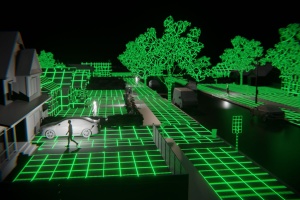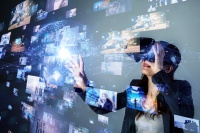Difference between revisions of "Bliss"
(added image for virtual reality) |
(reformat image) |
||
| Line 13: | Line 13: | ||
===Replacement for Reality === | ===Replacement for Reality === | ||
The technology seen in the film is a futuristic version of the virtual reality devices seen and commonly used today.<ref> VR home. (n.d.). Retrieved March 11, 2021, from https://arvr.google.com/vr/ </ref> As this technology gets more and more realistic, there is the chance it can replace authentic human interaction, as seen in the film. Humans are social mammals and require communication. Human enjoy social medias and, with the emergence of virtual technologies, Virtual Reality.<ref name=Waralak> Siricharoen, Waralak. (2019). The Effect of Virtual Reality as a form of Escapism. Retrieved March 11, 2021 from https://www.researchgate.net/profile/Waralak-Siricharoen/publication/336128788_The_Effect_of_Virtual_Reality_as_a_form_of_Escapism/links/5d90c8e992851c33e9487ffd/The-Effect-of-Virtual-Reality-as-a-form-of-Escapism.pdf. </ref> Virtual reality and simulation technology can be used as a form of escapism, creating feelings of relaxation if in moderation or of loneliness if over-indulged. <ref name=Waralak> </ref> | The technology seen in the film is a futuristic version of the virtual reality devices seen and commonly used today.<ref> VR home. (n.d.). Retrieved March 11, 2021, from https://arvr.google.com/vr/ </ref> As this technology gets more and more realistic, there is the chance it can replace authentic human interaction, as seen in the film. Humans are social mammals and require communication. Human enjoy social medias and, with the emergence of virtual technologies, Virtual Reality.<ref name=Waralak> Siricharoen, Waralak. (2019). The Effect of Virtual Reality as a form of Escapism. Retrieved March 11, 2021 from https://www.researchgate.net/profile/Waralak-Siricharoen/publication/336128788_The_Effect_of_Virtual_Reality_as_a_form_of_Escapism/links/5d90c8e992851c33e9487ffd/The-Effect-of-Virtual-Reality-as-a-form-of-Escapism.pdf. </ref> Virtual reality and simulation technology can be used as a form of escapism, creating feelings of relaxation if in moderation or of loneliness if over-indulged. <ref name=Waralak> </ref> | ||
| − | + | ||
| − | + | ||
[[File:haase7.jpeg|200px|right|thumb|Virtual Reality headset. https://learn.g2.com/virtual-reality]] | [[File:haase7.jpeg|200px|right|thumb|Virtual Reality headset. https://learn.g2.com/virtual-reality]] | ||
| + | Spiegel writes that there are four major areas of moral concern and social hazard regarding Virtual Reality which raise questions of public policy: mental health risks, personal neglect of actual bodies and physiological environment, personal privacy, and social risks. <ref name=spiegel>Spiegel, J.S. (2018). The Ethics of Virtual Reality Technology: Social Hazards and Public Policy Recommendations. Sci Eng Ethics 24, 1537–1550. https://doi.org/10.1007/s11948-017-9979-y</ref> Risks to mental health include anxiety, depression, social phobias, and potential neurological problems. <ref name=spiegel></ref> VR technology can also create a false sense of agency that violates privacy and personally manipulates beliefs, emotions, and behavior. <ref name=spiegel></ref> The illusions that VR creates has been referred to as “consensual hallucinations” and draw on specific political, ideological, and mystical beliefs as essential aspects of their moral foundation <ref name=mantovani> Mantovani, G. (1995). Virtual Reality as a Communication Environment: Consensual Hallucination, Fiction, and Possible Selves. Human Relations, 48(6), 669–683. https://doi.org/10.1177/001872679504800604</ref> The foundations these virtual realities are built on allow for social hazards and other moral concerns to be easily transferred between people. A 2014 study of 689,000 Facebook users showed that emotional states can be transferred to others via emotional contagion, leading people to experience the same emotions without their awareness. <ref name=kramer>Kramer A., Guillory J., Hancock, J. (2014). [https://www.pnas.org/content/111/24/8788.short Experimental evidence of massive-scale emotional contagion through social networks]. Proceedings of the National Academy of Sciences of the United States of America.</ref> This study shows that behavioral influence occurs on the scale of social media and similarly virtual reality. The ongoing convergence of virtual realities and social networks - Virtual Reality Social Networks (VRSN) - pose threats to informational, physical, and associational privacy and autonomy in terms of freedom, knowledge, and authenticity. <ref name=obrolchain>O’Brolcháin, F., Jacquemard, T., Monaghan, D., O’Connor, N., Novitzky, P., & Gordijn, B. (2016). The convergence of virtual reality and social networks: threats to privacy and autonomy. Science and engineering ethics, 22(1), 1-29.</ref> O’Brolcháin et. al. propose a number of recommendations for policy-makers and users to overcome these ethical dilemmas, including strong legislation in information limits for companies and examination of contracts being offered to users of VRSN technologies. <ref name=obrolchain></ref> | ||
| + | |||
===Unintended Bias === | ===Unintended Bias === | ||
In the film, Greg became attached to the simulated world, and it became his real reality. New technological breakthroughs, if not designed carefully and thoughtfully, like the Brainbox, can have unintended results. For example, [https://homepages.rpi.edu/~winner/ Langdon Winner] describes how the simple design of an overpass in Long Island caused years of subtle discrimination of poor people and African Americans, who at the time normally used public transit.<ref name=winner> Winner, L. (1980). Do Artifacts Have Politics? Daedalus, 109(1), 121-136. Retrieved March 11, 2021, from http://www.jstor.org/stable/20024652 </ref> One engineer’s bias to created discrimination in society. Algorithms collecting micro and macro data are being designed to make decisions on real people. <ref> Turner-Lee, N., Resnick, P., & Barton, G. (2019, October 25). Algorithmic bias detection and mitigation: Best practices and policies to reduce consumer harms. Retrieved March 11, 2021, from https://www.brookings.edu/research/algorithmic-bias-detection-and-mitigation-best-practices-and-policies-to-reduce-consumer-harms/ </ref> Winner says that one software developer can put bias into a given product to lend intended or unintended consequences. <ref name=winner></ref> | In the film, Greg became attached to the simulated world, and it became his real reality. New technological breakthroughs, if not designed carefully and thoughtfully, like the Brainbox, can have unintended results. For example, [https://homepages.rpi.edu/~winner/ Langdon Winner] describes how the simple design of an overpass in Long Island caused years of subtle discrimination of poor people and African Americans, who at the time normally used public transit.<ref name=winner> Winner, L. (1980). Do Artifacts Have Politics? Daedalus, 109(1), 121-136. Retrieved March 11, 2021, from http://www.jstor.org/stable/20024652 </ref> One engineer’s bias to created discrimination in society. Algorithms collecting micro and macro data are being designed to make decisions on real people. <ref> Turner-Lee, N., Resnick, P., & Barton, G. (2019, October 25). Algorithmic bias detection and mitigation: Best practices and policies to reduce consumer harms. Retrieved March 11, 2021, from https://www.brookings.edu/research/algorithmic-bias-detection-and-mitigation-best-practices-and-policies-to-reduce-consumer-harms/ </ref> Winner says that one software developer can put bias into a given product to lend intended or unintended consequences. <ref name=winner></ref> | ||
Revision as of 19:46, 18 March 2021

Bliss (2021) is a new, drama-science fiction, Prime Original film on Amazon Prime. The movie was directed by Mike Cahill and stars high-profile actors such as Salma Hayek and Owen Wilson.[1] Bliss follows the main character, Greg Wittle, as his mundane life turns upside down when he discovers first-hand that everyone around him is just a part of a computer simulation except, his new companion, Isabel. There are ethical implications with regards to the computer simulation that is explored through the film and in terms of consequences on users and society.
Contents
Plot
Bliss begins in a dreary office with Greg Wittle (Owen Wilson) sketching a house in extreme detail. Due to his lack of concentration, among other reasons, Greg is told to go to his boss’s office to be fired. Then, Greg accidentally kills his boss. In a panic, he flees to the bar across the street where he meets the disheveled, homeless Isabel Clemens (Salma Hayek). Isabel tells Greg that they are living in a simulation and nothing around them is real. After that, Greg and Isabel explore poverty-ridden Los Angeles. They take the yellow crystal to give them control of the simulated world and can live freely. Eventually, Greg’s beliefs begin to waver, so Isabel decides to take him back to the real world by taking the blue crystals. On arriving back, all of Greg’s dreams have come true. He discovers the house he drew earlier was his real home. It is the perfect world. But the simulated world begins to meld with the real world, leading Greg and Isabel to go back into the simulated world. The film ends with Greg choosing between the two worlds, the two versions of himself.
The Simulation

A computer simulation is a computer program that uses a model of a real system to duplicate the functional relationships within the real system.[2] The technology that created the simulated world in the film was known as the Brainbox. All of the real participants were placed into the same world for research purposes. The computer-created people were known as FGP (fake generated person). The idea behind the world was to explore the not-so-perfect pieces of oneself, without the fear of death. The FGPs are periodically respawned if they ever die. A similar concept is developed in the TV series Westworld. Virtual Reality is a form of a computer simulation in which the user experiences and can interact with the artificial 3D world created by the simulation.[3]
Ethical Issues
Replacement for Reality
The technology seen in the film is a futuristic version of the virtual reality devices seen and commonly used today.[4] As this technology gets more and more realistic, there is the chance it can replace authentic human interaction, as seen in the film. Humans are social mammals and require communication. Human enjoy social medias and, with the emergence of virtual technologies, Virtual Reality.[5] Virtual reality and simulation technology can be used as a form of escapism, creating feelings of relaxation if in moderation or of loneliness if over-indulged. [5]

Spiegel writes that there are four major areas of moral concern and social hazard regarding Virtual Reality which raise questions of public policy: mental health risks, personal neglect of actual bodies and physiological environment, personal privacy, and social risks. [6] Risks to mental health include anxiety, depression, social phobias, and potential neurological problems. [6] VR technology can also create a false sense of agency that violates privacy and personally manipulates beliefs, emotions, and behavior. [6] The illusions that VR creates has been referred to as “consensual hallucinations” and draw on specific political, ideological, and mystical beliefs as essential aspects of their moral foundation [7] The foundations these virtual realities are built on allow for social hazards and other moral concerns to be easily transferred between people. A 2014 study of 689,000 Facebook users showed that emotional states can be transferred to others via emotional contagion, leading people to experience the same emotions without their awareness. [8] This study shows that behavioral influence occurs on the scale of social media and similarly virtual reality. The ongoing convergence of virtual realities and social networks - Virtual Reality Social Networks (VRSN) - pose threats to informational, physical, and associational privacy and autonomy in terms of freedom, knowledge, and authenticity. [9] O’Brolcháin et. al. propose a number of recommendations for policy-makers and users to overcome these ethical dilemmas, including strong legislation in information limits for companies and examination of contracts being offered to users of VRSN technologies. [9]
Unintended Bias
In the film, Greg became attached to the simulated world, and it became his real reality. New technological breakthroughs, if not designed carefully and thoughtfully, like the Brainbox, can have unintended results. For example, Langdon Winner describes how the simple design of an overpass in Long Island caused years of subtle discrimination of poor people and African Americans, who at the time normally used public transit.[10] One engineer’s bias to created discrimination in society. Algorithms collecting micro and macro data are being designed to make decisions on real people. [11] Winner says that one software developer can put bias into a given product to lend intended or unintended consequences. [10]
Consequences for Users
The usage of virtual reality/simulation technology can have psychological impacts on the user.[12] In the film, Greg and Isabel live life without consequences. Greg can kill his boss and get away with it. If someone is living their perceived life with no penalties, they are more likely to do more negative things. A psychological study has been done to learn if real, lasting consequences can occur from interacting with virtual reality games. The researchers discovered that an individual playing a virtual reality game can experience intense negative emotions. They followed up and concluded that the participants utilizing the virtual reality had negative emotions that lasted up to a day as compared to participants playing a similar game on a laptop.[12] The findings show that the negative emotions created during an immersive experience can cause memory rumination leading to a more depressed mood.[13]
Equal Access Right
The ideal world that Greg and Isabel are in is utopian. Everyone has the time and money to explore their passions, and climate change has been reversed. The purpose of Isabel’s research is to show that her simulation technology should be a human right. At that time in the film, there was not positive consensus with the benefits of her technology for various reasons, equal access to all being one of them. Equal access to information and technology being a human right is an ongoing debate. Two terms that are often used when discussing this debate are equality and equity. Formally, equality is defined as the quality or state of being equal.[14] Equity is defined as justice according to natural law or right, specifically, freedom from bias or favoritism.[15] There is a balance between reaching equality and equity in regard to access to information and technology. If there is too much of a focus on equity, there will be backlash from those who resent such programs as ‘unfair’.[16] Achieving this balance is a goal of librarians and other scholars involved in information technology, since they play a large role in creating change.[16]. To create fair and equal access, there needs to be justice from equity.[16]
References
- ↑ Bliss. (2021). Amazon Prime. Retrieved 11 March 2021, from https://www.amazon.com/Bliss-Salma-Hayek/dp/B08RMNMGNB
- ↑ T. (2017, April 27). Computer simulation. Retrieved March 11, 2021, from https://www.britannica.com/technology/computer-simulation
- ↑ Mitchell, C. (2020, November 21). Virtual reality. Retrieved March 11, 2021, from https://www.investopedia.com/terms/v/virtual-reality.asp
- ↑ VR home. (n.d.). Retrieved March 11, 2021, from https://arvr.google.com/vr/
- ↑ 5.0 5.1 Siricharoen, Waralak. (2019). The Effect of Virtual Reality as a form of Escapism. Retrieved March 11, 2021 from https://www.researchgate.net/profile/Waralak-Siricharoen/publication/336128788_The_Effect_of_Virtual_Reality_as_a_form_of_Escapism/links/5d90c8e992851c33e9487ffd/The-Effect-of-Virtual-Reality-as-a-form-of-Escapism.pdf.
- ↑ 6.0 6.1 6.2 Spiegel, J.S. (2018). The Ethics of Virtual Reality Technology: Social Hazards and Public Policy Recommendations. Sci Eng Ethics 24, 1537–1550. https://doi.org/10.1007/s11948-017-9979-y
- ↑ Mantovani, G. (1995). Virtual Reality as a Communication Environment: Consensual Hallucination, Fiction, and Possible Selves. Human Relations, 48(6), 669–683. https://doi.org/10.1177/001872679504800604
- ↑ Kramer A., Guillory J., Hancock, J. (2014). Experimental evidence of massive-scale emotional contagion through social networks. Proceedings of the National Academy of Sciences of the United States of America.
- ↑ 9.0 9.1 O’Brolcháin, F., Jacquemard, T., Monaghan, D., O’Connor, N., Novitzky, P., & Gordijn, B. (2016). The convergence of virtual reality and social networks: threats to privacy and autonomy. Science and engineering ethics, 22(1), 1-29.
- ↑ 10.0 10.1 Winner, L. (1980). Do Artifacts Have Politics? Daedalus, 109(1), 121-136. Retrieved March 11, 2021, from http://www.jstor.org/stable/20024652
- ↑ Turner-Lee, N., Resnick, P., & Barton, G. (2019, October 25). Algorithmic bias detection and mitigation: Best practices and policies to reduce consumer harms. Retrieved March 11, 2021, from https://www.brookings.edu/research/algorithmic-bias-detection-and-mitigation-best-practices-and-policies-to-reduce-consumer-harms/
- ↑ 12.0 12.1 Lavoie, R., Main, K., King, C., & King, D. (2020). Virtual experience, real consequences: The potential negative emotional consequences of virtual reality gameplay. Virtual Reality, 25(1), 69-81. doi:10.1007/s10055-020-00440-y
- ↑ Park, R. J., Goodyer, I. M., & Teasdale, J. D. (2004). Effects of induced rumination and distraction on mood and overgeneral autobiographical memory in adolescent Major Depressive Disorder and controls. Journal of child psychology and psychiatry, and allied disciplines, 45(5), 996–1006. https://doi.org/10.1111/j.1469-7610.2004.t01-1-00291.x
- ↑ Equality. (n.d.). Retrieved March 11, 2021, from https://www.merriam-webster.com/dictionary/equality
- ↑ Equity. (n.d.). Retrieved March 11, 2021, from https://www.merriam-webster.com/dictionary/equity
- ↑ 16.0 16.1 16.2 Admin. (2017, May 20). Equality and equity of access: What's the difference? Retrieved March 11, 2021, from http://www.ala.org/advocacy/intfreedom/equalityequity